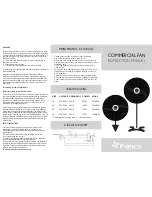
3
To prevent spreading of vibrations to the
surroundings, anti-vibration mountings
may be inserted between fan and
support, and flexible connections can be
fitted in the ducts before and after the
fan. The connections are available as
optional extras.
Secure anti-vibration mountings (figure
2) in the support frame by means of bolts.
Mount base plates for attachment in the
foundation/floor at the bottom of the
rubber element.
The anti-vibration mountings serve to
ensure the natural frequency of the
system is kept below 10 Hz and that the
damping is at least 80%.
To load the vibration dampers evenly the
fan must be the distance X from the front
damper. The distance is found in the
specific AirBox calculation. See figure 3.
Loading of dampers vary depending on
air pressure.
Uneven loading can strain and impair
the function of the dampers.
4.4 Duct connection
The duct or inlet cone on the inlet side are
to ensure smooth and undisturbed
airflows. Installation space must be
optimal for the fans to run at max.
allowable speed. Fan speeds must be
reduced if the installation space is less
than optimal. See table and figures
below.
Flexible connections can be placed at
least ½D in front of fan.
AZN and AZW fans are prepared for
circular duct connections on inlet and
outlet sides.
Flanges supplied as standard for type
AZN comply with Eurovent 1/2, and for
type AZW comply with DIN 24154 row
4.
Systems with higher vibration levels or
more exacting performance
requirements must be provided with
expansion joints between fan and duct.
It is important to allow for free areas to
facilitate mounting and dismounting as
well as ordinary maintenance.
4.5 Electric connection
Connection of supply voltage is done
directly in the terminal box mounted on
the outside of the fan casing.
The motor cables are connected
according to the connection diagram on
the inside of the terminal box lid.
After making the connections in the
Figure 2.
Support frame for AZN
Important:
The natural frequency of
the support must differ at
least 20% from the fan
speed.
Figure 3.
Fan with support frame
03
02
01
X
Fan size,
ØD, [mm]
RPM
1
1.Fan speeds depend on the installation space.
Optimal
Reduced
Hub di
am
et
er
s
35
0
500
3660
3483
560
3460
3286
630
3238
3059
710
3000
2804
800
2751
2523
900
2498
2217
1000
2270
1918
1120
1900
1568
1250
1500
1201
H
u
b
d
iam
et
ers
56
0
1000
2034
1904
1120
1893
1727
1250
1751
1552
1400
1599
1371
1600
1419
1166
1800
1262
1002
2000
1130
878
Table 5.
Max. allowable speed at 20 °C
Figure 4.
Installation in duct
Figure 5.
Duct installation with inlet
cone and wire guard
Figure 6.
Optimal installation space
3 x D
>
3 x D
>
½D
r >
D
>
D
>
D = Fan diameter
Built into duct
Free inlet
Figure 7.
Reduced installation space
Important:
The fan cannot be used
for support of ducts.
Important:
The installation and
connection to the supply
network must be done by
authorised personnel,
follow current legislation
and comply with
EN 60079-14.
Important:
Only fans with steel hubs
may be run in reverse.
Reversible operation
increases the risk of fan
stalling. The service life is
shortened, if the fan
stalls.
D
>
D
>
½D
r >
½D
>
D
>
Built into duct
Free inlet
D = Fan diameter




























